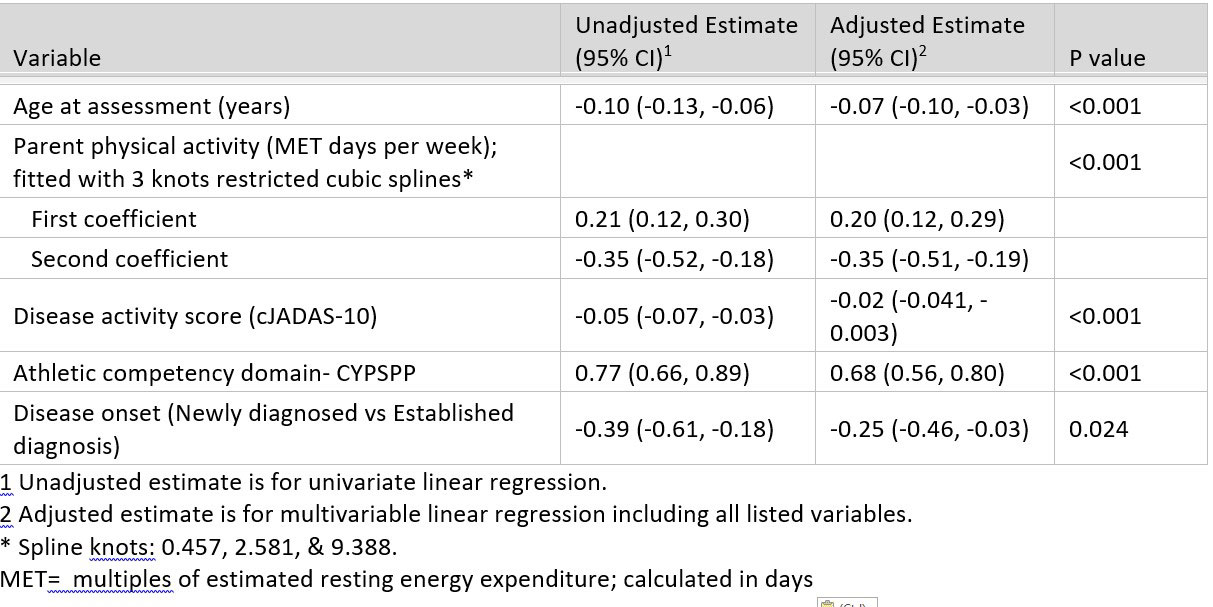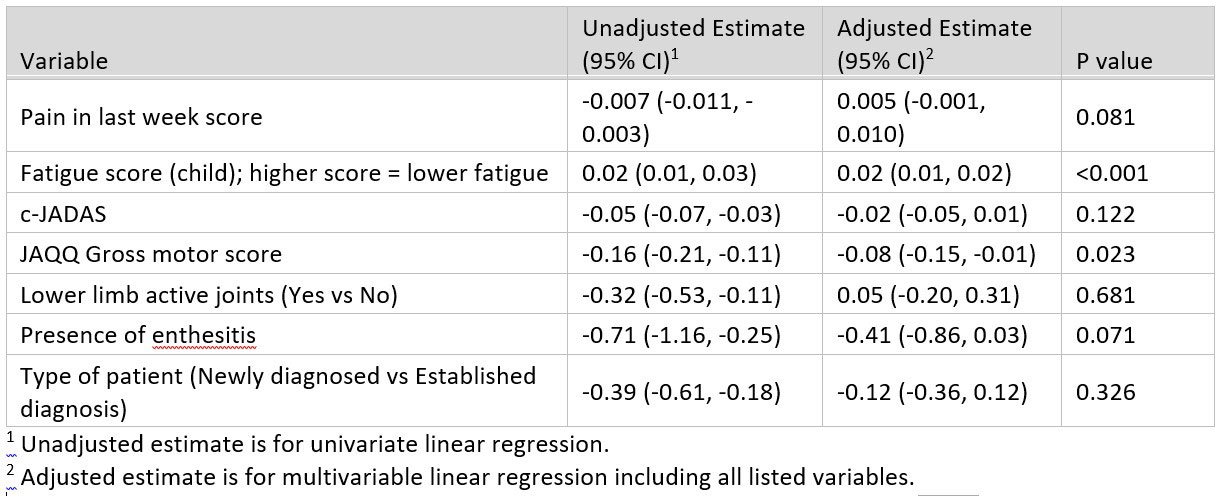Session Information
Session Type: Poster Session B
Session Time: 9:00AM-10:30AM
Background/Purpose: Participation in physical activity (PA) is a concern of children with JIA , however, factors associated with PA in these children are incompletely understood. LEAP is a Canada-wide prospective research program focused on studying PA in relation to disease and other factors in children with JIA. Our objectives are to examine the associations of a) patient characteristics with level of PA and b) PA with JIA disease-related factors at baseline study entry.
Methods: Children with definite JIA, age 8-16 y, seen at 12 Canadian pediatric rheumatology centres from 2012-2016 were enrolled in LEAP. Participants were either newly diagnosed within 6 mo, or had > 6 mo of established disease after diagnosis. Data collected included clinical and demographic data, active joint count, physician/parent global assessment, measures of fatigue (PedsQL Fatigue Scale), pain, function (JAQQ Gross motor scale), and health related quality of life (JAQQ). JIA activity was measured by calculated cJADAS10 (Juvenile Arthritis Disease Activity Score). PA is the primary outcome of the study, measured by a valid self report tool, The Physical Activity Questionnaire (PAQ; Child age 8-13 and Adolescent age 14-17 versions). Sex and age-specific z-scores for the PAQ were calculated using a normative population. Child self-report of sport/athletic competence was measured by the Child and Youth Physical Self Perception Profile (CY-PSPP). Parental PA was measured by the International PA Questionnaire. In addition to descriptive statistics, we fit 2 linear regression models to examine associations between disease activity, disease related variables, and PA.
Results: 573 participants were included; 164 newly diagnosed JIA, 409 established JIA. Newly diagnosed participants had higher JIA disease activity (cJADAS10 median 6.0, IQR 3.2,11.6) and higher functional impairment (JAQQ Gross Motor score median 3.2, IQR 1.8,4.8) compared with those with established disease (cJADAS10 median 1.0, IQR 0.0,4.2; JAQQ Gross Motor score median 1.6,IQR 1.0, 3.0). Mean PAQ z-score was lower in both JIA groups compared with healthy children, with mean -0.5 (SD 1.2) for newly diagnosed and mean -0.1(SD 1.2) for established disease; a z-score of -2 or lower was found in 5% of each JIA group vs 2.5% in the reference group. Children with higher cJADAS10 scores and those newly diagnosed had lower PAQ z-scores. Higher parent PA and higher self report child athletic competence was associated with higher PA (Table 1). High levels of fatigue had the strongest association with low PA in a model of disease related factors. Higher pain score was associated with lower PA, but less significant after adjustment. The gross motor score of JAQQ associated with PA, and there was a trend toward lower PA in children with enthesitis. (Table 2)
Conclusion: PA is lower in children with JIA compared with healthy peers, particularly in children newly diagnosed with high disease activity. Parental PA was positively associated with PA of children with JIA, as well as children’s self reported competence for exercise. Fatigue, more than pain, has a strong negative association with PA in JIA. Analysis of the longitudinal trajectory of PA in children with JIA in the LEAP study will provide further insights.
(non-significant factors: parental level of education, median household income, season of the year based on school year, male sex)
To cite this abstract in AMA style:
Tucker L, Guzman J, Hayawi L, Barrowman N, Macdonald H, Houghton K, Cabral D, Lang B, Rumsey D, Stringer E, Tse S, Berard R, Leblanc C, Gerschman T, Heale L, Watanabe-Duffy K, Campillo S, Shiff N, Duffy C. A Cross-Sectional Description of Physical Activity (PA) in Children with Juvenile Idiopathic Arthritis (JIA): The LEAP Study (Linking Exercise, Activity, and Pathophysiology in Canadian Children with Arthritis) [abstract]. Arthritis Rheumatol. 2022; 74 (suppl 9). https://acrabstracts.org/abstract/a-cross-sectional-description-of-physical-activity-pa-in-children-with-juvenile-idiopathic-arthritis-jia-the-leap-study-linking-exercise-activity-and-pathophysiology-in-canadian-children-with/. Accessed .« Back to ACR Convergence 2022
ACR Meeting Abstracts - https://acrabstracts.org/abstract/a-cross-sectional-description-of-physical-activity-pa-in-children-with-juvenile-idiopathic-arthritis-jia-the-leap-study-linking-exercise-activity-and-pathophysiology-in-canadian-children-with/


